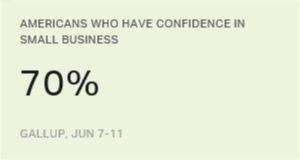PRINCETON, NJ -- Gallup's initial measure of Americans' 2010 Christmas spending intentions finds consumers planning to spend an average of $715 on gifts, roughly on par with the $740 recorded in October 2009.

The $25 decrease in Americans' holiday spending intentions between October 2009 and October 2010 (not a statistically significant change) contrasts with a $61 year-over-year reduction in intended spending found last October and a $108 reduction found a year prior.
The muted nature of this year's decline is reflected in consumers' own evaluations of their spending changes. According to the Oct. 7-10 poll, 27% of Americans intend to spend less on Christmas gifts this year than what they spent last Christmas -- higher than the 11% who now say they will spend more, but down from the 35% and 33% in 2008 and 2009 saying they would spend less. Prior to the recent recession, Americans were much more closely divided over whether their holiday spending would exceed or trail their spending of the prior year, while more said their spending would be "about the same."

Gallup will update this measure in early November and again in early December. The December forecast has historically been a strong indicator of the direction of holiday retail sales, forecasting the extent to which sales will be higher or lower than the previous year. The October figure is not always predictive of the December forecast, however. In 2002, consumers' estimates of how much they would spend increased between October and December; in 2007 and 2008, their estimates decreased, while in 2009, they stayed about the same.

Bottom Line
Americans' average prediction of the total amount they will spend on Christmas gifts this year is not highly encouraging for retailers, who may be hoping for a return to pre-recessionary buying habits. The good news, however, is that the $25 decline in this year's October forecast is far less than what Gallup found in each of the prior two years at this stage in the season and, according to Gallup modeling, would point to a fairly flat year in holiday retail sales if it holds at this level through December. According to the National Retail Federation, there was a steep 3.9% year-over-year decline in holiday spending in 2008. Compared with that, a repeat of the "flat" holiday sales seen in 2009 may be a tolerable, if unwelcome, outcome for retailers who have grown accustomed to the new, more budget-conscious consumer.
Results for this Gallup poll are based on telephone interviews conducted Oct. 7-10, 2010, with a random sample of 1,025 adults, aged 18 and older, living in the continental U.S., selected using random-digit-dial sampling.
For results based on the total sample of national adults, one can say with 95% confidence that the maximum margin of sampling error is ±4 percentage points.
Interviews are conducted with respondents on landline telephones (for respondents with a landline telephone) and cellular phones (for respondents who are cell phone-only). Each sample includes a minimum quota of 150 cell phone-only respondents and 850 landline respondents, with additional minimum quotas among landline respondents for gender within region. Landline respondents are chosen at random within each household on the basis of which member had the most recent birthday.
Samples are weighted by gender, age, race, education, region, and phone lines. Demographic weighting targets are based on the March 2009 Current Population Survey figures for the aged 18 and older non-institutionalized population living in continental U.S. telephone households. All reported margins of sampling error include the computed design effects for weighting and sample design.
In addition to sampling error, question wording and practical difficulties in conducting surveys can introduce error or bias into the findings of public opinion polls.
View methodology, full question results, and trend data.
For more details on Gallup's polling methodology, visit www.gallup.com.
